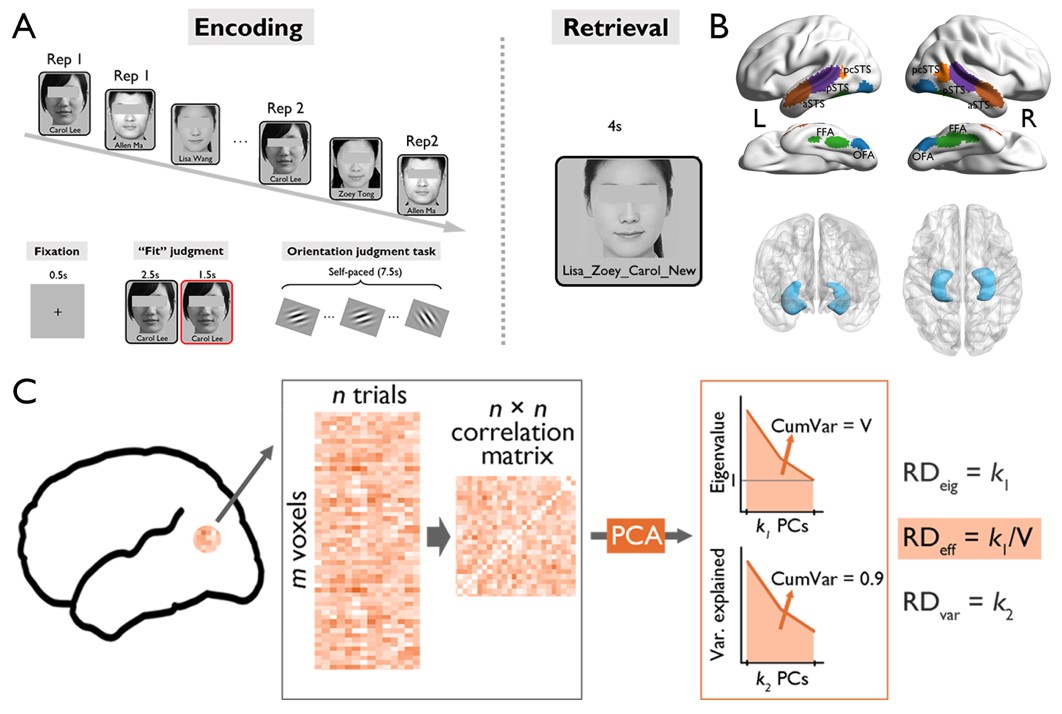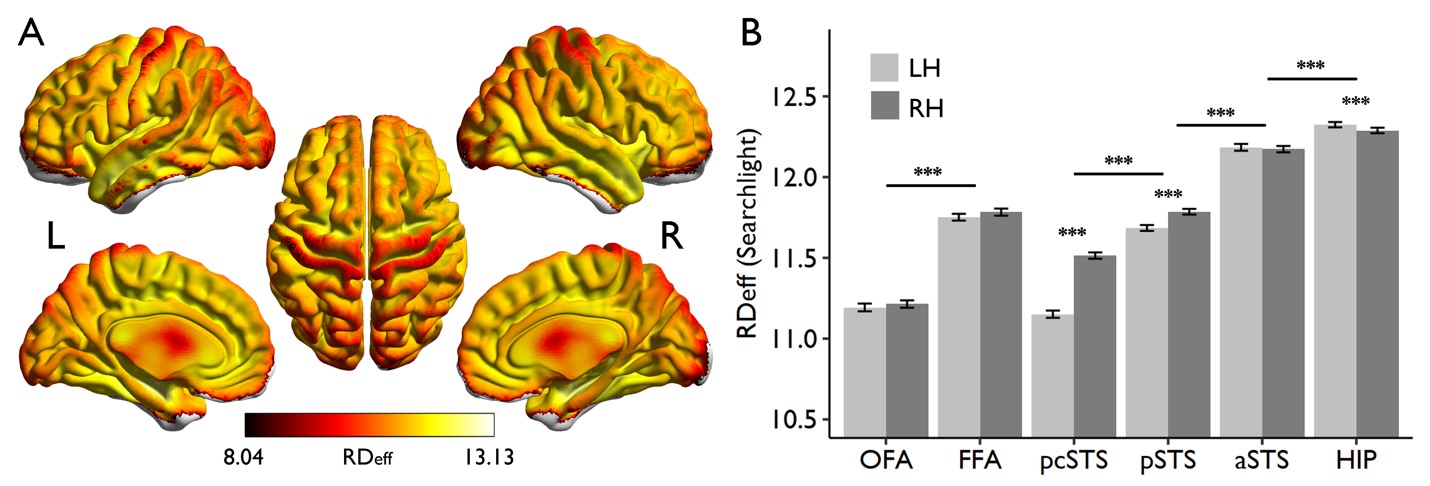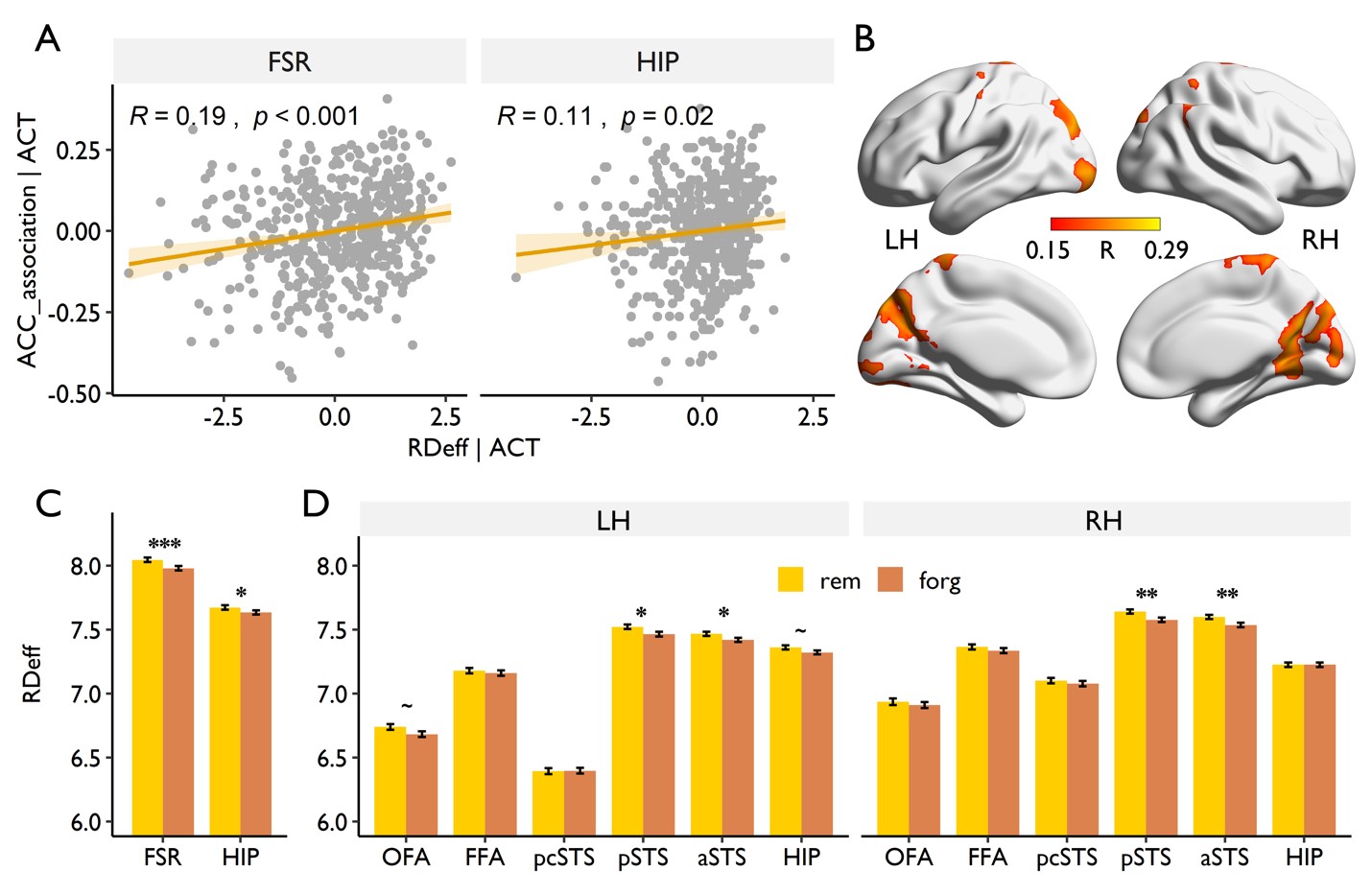April 20th, 2022, Science Advances published a research paper from Dr. Gui Xue’s lab, titled "Higher-dimensional neural representations predict better episodic memory." This article revealed the neural mechanism by which high-dimensional neural representations improve memory performance.
Memory is the cornerstone of human intelligence. Memory ability varies across different individuals, but the neural representation mechanism that affects individual memory is still unclear. Dr. Gui Xue's group has been working on uncovering the neural representation mechanism of episodic memory in the human brain (Xue, 2018, TICS). Their previous research examined the representational fidelity of materials and its relationship to memory and found that high neural representational fidelity was associated with better memory performance (Xue et al., 2010, Science; Lu et al., 2015, Current Biology), while the decline in the neural representational fidelity in the elderly leads to a decline in memory (Zheng et al., 2017, Cerebral Cortex).
In this study, the authors adopted a new method of neural representation --representational dimensionality (RD) -- to characterize how the brain represents and distinguishes multiple materials of the same category (such as human faces). Low-dimensional representations suggest that human brains represent different materials with few common features, making neural representations more robust and generalizable. In contrast, high-dimensional representations suggest that human brains represent different materials with more features, making neural representations more abundant and distinguishable. However, are there individual differences in the RD? How is RD related to the individual's memory ability? And what are the factors that affect the RD?
This study used a large sample task-based fMRI dataset (n = 468) of face-name associative memory task from the "Cognitive Neurogenetic Research in Chinese Young Adults" (CNSCYA) project in the lab and a new index of RD (effective representational dimensionality, RDeff) (Figure 1) to answer these questions.
Figure 1.Schematic of experimental paradigm, the definition of regions of interest, and estimation of representational dimensionality.
The study found that RD was much higher than the dimensionality estimated from the computational model (i.e., OpenFace) that was required to identify different faces (i.e., 4) but was significantly lower than the maximal dimensions (i.e., 29), showing high-dimensional and robust properties. Interestingly, the higher-order facial regions had higher RD, and the hippocampus had the highest dimension of the regions interrogated (Figure 2). These results support a hierarchical neural representation in the human brain for facial processing, as well as a highly sparse neural representation of the hippocampus.
Figure 2. Dimensionality reflects hierarchical face representations.
An important finding of this study is that RD promotes the efficient encoding of human episodic memory. Specifically, subsequently remembered faces showed greater dimensionality than subsequently forgotten faces, and individuals with higher representational dimensions had better memory performance (Figure 3). These results suggest that high-dimensional neural representations may optimize information encoding and promote memory.
Figure 3. Association between representational dimensionality and memory performance.
Furthermore, this study examined underlying mechanisms that affect representational dimensionality. They found that low-dimensional variance was significantly negatively correlated with both frontoparietal activity and memory ability (Figure 4). Mediation analysis revealed that activity in the frontoparietal brain region increased RD of the posterior brain region (especially the superior temporal sulcus) by reducing the correlations of local neural responses in the posterior brain region (Figure 4). These results suggest that top-down attentional control can suppress low-dimensional shared variance and reduce the correlation of local neural responses, thereby increasing the encoding space and representational dimensionality, ultimately leading to better episodic memory performance.
Figure 4. Top-down attentional modulations of representational dimensionality.
This work was supported by the National Natural Science Foundation of China and the China-Israel International Cooperation Research Foundation. The first author is Jintao Sheng, and the corresponding author is Professor Gui Xue.
Link to the article: Jintao Sheng, Liang Zhang, Chuqi Liu, Jing Liu, Junjiao Feng, Yu Zhou, Huinan Hu, Gui Xue*. Higher-dimensional neural representations predict better episodic memory. Science Advances, 2022, 8(16), eabm3829. https://www.science.org/doi/10.1126/sciadv.abm3829
Relevant studies from the lab:
1. Xue G*. 2018. The Neural Representations Underlying Human Episodic Memory. Trends Cogn Sci. 22(6): 544-561. Review.
2. Zheng L, Gao Z, Xiao X, Ye Z, Chen C, Xue G*. 2017. Reduced Fidelity of Neural Representation Underlies Episodic Memory Decline in Normal Aging. Cereb Cortex. doi: 10.1093/cercor/bhx130.
3. Lu Y, Wang C, Chen C, Xue G*. 2015. Spatiotemporal Neural Pattern Similarity Supports Episodic Memory. Current Biology. 25(6): 780-5
4. Xue G, Dong, Q, Chen, C, Lu ZL, Poldrack RA. 2010. Greater neural pattern similarity across repetitions is associated with better later memory. Science. 330(6000): 97-101
Dr. Xue’s lab: http://cbls.bnu.edu.cn/






